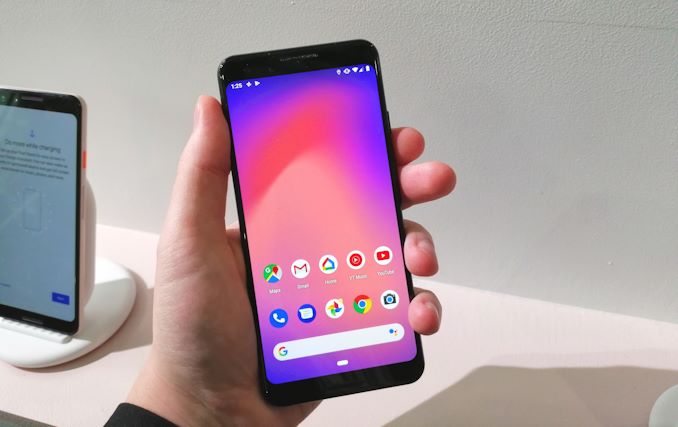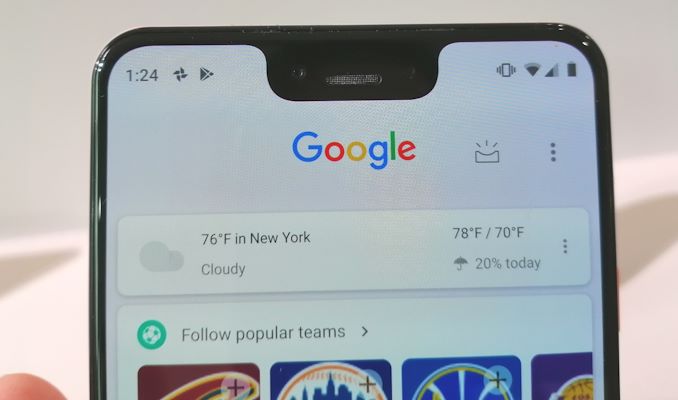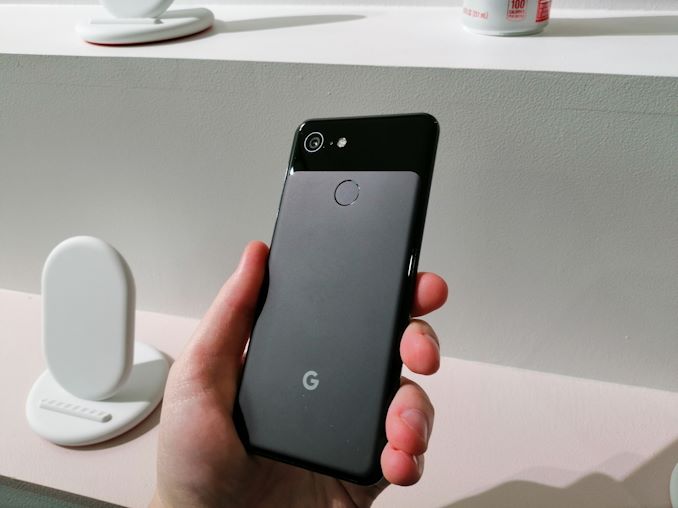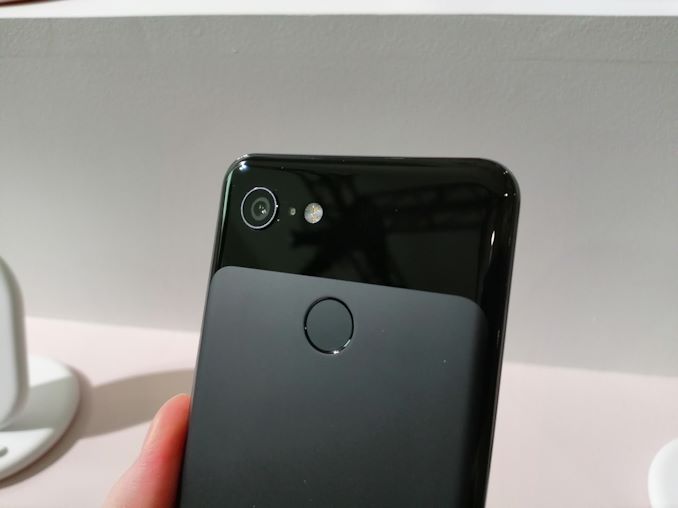Google Launches the Pixel 3 & Pixel 3 XL
by Andrei Frumusanu on October 9, 2018 2:00 PM EST- Posted in
- Smartphones
- Mobile
- Pixel 3
- Pixel 3 XL
It has likely been the most leaked phone in existence, and while there’s a lot we’ve known about the new Pixel 3’s – today Google has finally officially announced the new devices at its launch event in New York. Here’s the summary of the new hardware of software of Google’s new flagship smartphone for the end of 2018.
The Pixel 2 phones have been relatively successful phones for Google and grown to have a notable following. Today’s launched Pixel 3 devices iterate on last year’s phones, improving on aspects that differentiated Google’s phones from other manufacturers, such as the camera.
| Google Pixel 3's | |||
| Pixel 3 | Pixel 3 XL | ||
| SoC | Snapdragon 845 4x Kryo 385 Gold (Cortex A75 based) @ 2.8GHz 4x Kryo 385 Silver (Cortex A55 based) @ 1.76GHz |
||
| GPU | Adreno 630 @ 710MHz | ||
| DRAM | 4GB LPDDR4X | ||
| Display | 5.5" AMOLED 2160 x 1080 (18:9) |
6.3" P-OLED 2960 x 1440 (18.5:9) |
|
| Size | Height | 145.6 mm | 158.0 mm |
| Width | 68.2 mm | 76.6 mm | |
| Depth | 7.9 mm | 7.9 mm | |
| Weight | 148 grams | 184 grams | |
| Battery Capacity | 2915mAh | 3430mAh | |
| Wireless Charging | Qi | ||
| Rear Camera | 12.2 MP, f/1.8, 27mm (wide), 1/2.55", 1.4µm, OIS, dual pixel PDAF |
||
| Front Cameras | Dual 8MP modules Regular f/1.8 75° & wide angle f/2.2 97° FoV lenses |
||
| Storage | 64 GB / 128 GB | 64 GB / 128 GB | |
| I/O | USB-C | ||
| Wireless (local) | 802.11ac Wi-Fi + Bluetooth 5.0 LE + NFC | ||
| Cellular | CAT 16 (1Gbps DL / 75Mbps UL), 5x DL CA, 4x4 MIMO, LAA, 256-QAM DL and 64-QAM UL |
||
| Splash, Water, Dust Resistance | IPX8 (Water resistant up to 1m) |
||
| Dual-SIM | nano-SIM | ||
| Launch Price | 64 GB: $799 / £739 / 849€ 128 GB: $899 / £839 / 949€ |
64 GB: $899 / not avail. / 949€ 256 GB: $999 / £969 / 1049€ |
|
Hardware wise the new Pixel 3 and Pixel 3 XL are powered by this year’s Snapdragon 845 processor. We already saw Qualcomm’s SoC in a mass of handsets from a variety of vendors, and it performed excellently in every one of them. For the Pixel phones, what would likely be a bigger differentiation, is how Google will handle the software side of things. Qualcomm’s Snapdragon 845 scheduler differentiated a lot from the “vanilla” Android kernel – and I think Google will want to continue to use its own scheduling.
The device comes with 4GB of LPDDR4X. I don’t think this is an issue, even if some flagship devices this year sport larger capacities. Onboard storage comes in 64 and 128GB options.
Starting off with the design of the Pixel 3, Google has elongated the screen aspect ratio to 18:9 and reduced the top and bottom bezels compared to the Pixel 2. Over this updates the design with the trend with what we’ve seen in 2018, as phone’s screen-to-body ratio continues to grow.
The Pixel 3 XL is where Google is definitely taking a large design risk: The new XL also increases the screen-to-body ratio over the 2XL, however this comes with the introduction of a massive new screen notch. Now I can’t really be accused of being anti-notch, as I found it to be a complete non-issue on all of this year’s reviewed devices, including Huawei’s P20’s, the OnePlus 6 as well as the LG G7. However Google’s take on the notch is definitely weird: It’s almost twice as high as that of other vendors, which makes one question exactly how this will actually look in daily app usages and if it’s actually of any benefit in terms of notification bar space. Subjectively, it does look ridiculous, but we’ll hold off definitive conclusions until we’ve had time with the phone.
The new Pixels now introduce wireless charging, and this is thanks to the new all-glass backs of the phones. Google achieves the two-tone look by applying a new method that just etches part of the glass, leaving a similar glossy top as on the Pixel 2’s.
This year’s water resistance has been raised to an IPX8 rating, up from the IP67 of the Pixel 2’s. Google seemingly didn’t certify this year’s devices for dust resistance – hence the missing number in the IP rating. As a reminder, this doesn’t mean that the resistance is any worse.
Where the Pixel 2 XL didn’t shine is the screen: LG’s POLED panel on last year’s big phone suffered from large issues, with the biggest one being the screen’s terrible performance in low brightness, where it would just not be able to display darker colours and instead just clip to black. The new Pixel 3 XL at first glance seems to have improved a lot in this regard, and hopefully addresses what was in my opinion the Pixel 2 XL’s biggest issue.
The camera on the new Pixel 3’s sports the same hardware characteristics: a single f/1.8 12.2MP rear module with a 1.4µm sensor as well as OIS. We don’t have much information on the sensor or how the camera hardware improved at the time of writing.
What is clear though is that Google has vastly improved the software of the camera. The three highlight features are “Top shot”, “Super res zoom” and “Night sight”.
Top shot looks to be a continuous shooting mode buffer around the time you are pressing the shutter button. The phone saves pictures even before you pressed the button, and allows you to choose the best shots in a series.
Super resolution zoom is something I’m very excited about: Even though the new Pixel 3’s don’t have a dedicated zoom camera, they still provide a zoom functionality with increased image quality. What Google is doing here is taking multiple shots in a very fast burst (or either using a continuous camera stream), and making use of the slight spatial variations caused by the movement of the camera to get multiple shots. These are then interpolated together with help of the Pixel Visual Core’s processing capabilities to create a higher resolution image. It would be very interesting to see if Google is able to produce higher resolution shots not only when just zoomed in, but also at full frame.
Finally “Night sight” is something that sounds akin to Huawei’s new night mode – where the camera takes several exposures and recombines them in a stacked result that vastly improves the low-light performance of the phone.
As for the Pixel Visual Core – we’re not sure if this is the same silicon as last year, or if Google has iterated and provided with a successor chip.
The front-facing camera system has seen the addition of new wide-angle module, on top of the regular selfie camera. Both are 8MP units, with the regular one coming with an f/1.8 aperture and the wide angle offering an f/2.2 aperture.
The new Pixel 3’s speakers are said to have also been vastly improved, being 40% louder as well as being calibrated for better low and high frequencies.
Overall, today’s Pixel 3 launch event was very much centred around the camera, which Google confidently now calls the “best camera on a smartphone”. Certainly in terms of computational photography, it seems Google made big leaps, and I’m especially eager to see the new super resolution zoom and night sight modes work in practice.
Google offers the Pixel 3 starting at $799 for the 64GB model, and $899 for the 128GB model. The Pixel 3 XL starts similarly at $899 and comes in at $999 for the larger capacity. The Pixel 3’s are available for pre-order now, with full availability in the US starting on the 18th, and European and other countries starting on November 1st.
















86 Comments
View All Comments
jakeuten - Tuesday, October 9, 2018 - link
Do people really think that the iPhone Xs shot was metered properly? It looks like they turned the exposure compensation all the way down.milkywayer - Tuesday, October 9, 2018 - link
Dang the new changes make the pixel 3 xl attractive but its a shame Google wants to give me just three fiddy for a mint condition pixel 2 xl. I'll stick to it for the time being. As per sour grapes, I didn't like the new notch anyways.lilmoe - Tuesday, October 9, 2018 - link
What's wrong with the notch? It even looks like this!!|o___o|
😂😂😂
The hell they be smokin'
MonkeyPaw - Tuesday, October 9, 2018 - link
Yeah, the sky does not look near dark enough for a smartphone camera to suffer that badly. It’s as though they selected the sky as the metering point on the iPhone.philehidiot - Wednesday, October 10, 2018 - link
I hate it when companies do this. Treating me like an idiot means I won't buy their hardware. This, as you all say, is plainly a poorly metered shot done on purpose to mislead. If they're going to be this dishonest and think they can get away with blatant stuff like this, what other surprises are lurking in the product or features are being misrepresented to me? And if they're willing to lie at this stage, how are they going to treat me if there's a problem? Also is the T2 chip going to prevent people from replacing their displays with third party ones like Apple does?Tams80 - Wednesday, October 10, 2018 - link
Yeah, someone (or people) need a good smack in the head to bring them back to reality.It's actually quite rude to even assume people are that thick as to think that iPhone photo was normal.
Meteor2 - Tuesday, October 9, 2018 - link
Didn’t the Pixel 2 launch at $649? The new camera is an amazing piece of tech, but you have to be seriously keen on photography to justify that outlay.sing_electric - Wednesday, October 10, 2018 - link
Yes it did - it's a large price jump for a device that feels mostly iterative. The most direct competition is probably the Galaxy S9 - with a MSRP of $719 (but which is very frequently on sale, or includes generous "freebies" due to various promos, whereas the Pixels almost never go on sale until very late in their product cycle).For $80 less, you get a the a similar-ish glass-and-metal phone with the same SoC and RAM (in the US), larger, higher-res screen, headphone jack, a camera that's good (though maybe not as good). Plus, you could have had it 7 months before you could have had a Pixel 3.
In other words, Google is betting that it's software is worth $80.
thinkgadgetsme - Wednesday, October 10, 2018 - link
Small correction here, Samsung is selling Galaxy S9 in USA for $619, just checked today. So essentially google is selling $120 worth of software.sing_electric - Thursday, October 11, 2018 - link
You're right! Actually, if you buy direct from Samsung, you can get the 256GB version for $60 less than Google is charging for the 64GB Pixel. (Not that I really think that many people actually need that much storage on their phones, but, well, if you do...)